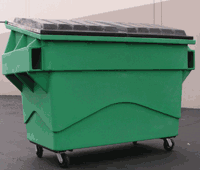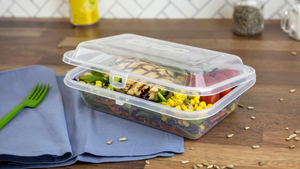Rotomolding broadens portfolio
The silicone Supavent for rotational molding tools properly vents rotomolds without clogging, helping ensure good pressurization and improved surface quality (see sidebar).La Plastecnica supplies two sizes of the Supavent (13 and 19 mm) as well as a smaller Smartvent product.
March 6, 2007
The silicone Supavent for rotational molding tools properly vents rotomolds without clogging, helping ensure good pressurization and improved surface quality (see sidebar).
La Plastecnica supplies two sizes of the Supavent (13 and 19 mm) as well as a smaller Smartvent product.
Nova Chemical's Surpass portfolio for rotomolding applies a proprietary reactor technology during resin manufacture for copolymer materials that offer high densities without losing stiffness or impact, allowing high-duress parts such as this dumpster. |
Rotational molding is no longer defined by polyethylene alone, with new materials opening new markets, and protecting old ones, such as fuel tanks.
From additives, to base resins, to polymer systems, suppliers to the rotational molding market have stepped up with new technologies to help the relatively staid rotomolding sector shake things up. Ciba Specialty Chemicals (Basel, Switzerland) is hoping to boost uptime with a developmental blend for rotomolders based on its FS technology. Sold as a complete system, it?s a next-generation antioxidant that stabilizes the resin within the rotomolding process, offers light stability, and reduces cycle times by 15-20%, due to lower process temperatures, according to Eric Wallis, new business development manager. In addition, Ciba reports a whiter natural part being created. The blend was in a test-marketing phase last fall, and Wallis says Ciba hopes to introduce it in the first quarter of 2007.
Another resin system promising cycle-time reductions for rotomolders uses its name to describe its goal?Better Parts Faster (BPF). Launched by A. Schulman (Akron, OH), BPF is built around the company's metallocene-modified XL 0370 resin, which has inherently high impact resistance, heat-deflection temperatures, and flexural modulus. According to Schulman's Greg LeFevre, BPF has consistently led to a 25% reduction in oven time, with subsequent cooling-time cuts in plant trials.
Schulman has tested the system with multiple PE compounds and has plans to experiment with cross-linked PE. BPF is in commercial use at two North American companies, and LeFevre sees opportunities in large parts using color compounds.
Don Martone, business manager for rotomolding at Nova Chemicals (Pittsburgh, PA), says his company is at work expanding its Surpass rotomolding portfolio, which launched in 2003 with two materials. A complement to its standard-grade Novapol line based on gas-phase PE, Surpass uses a proprietary reactor technology for copolymer materials that offer high densities without losing stiffness or impact. Nova?s developmental grades are showing cycle-time improvements, whiter coloring, and easier demolding, yielding opportunities for rotomolders.
A New Animal
After completing a project to expand the available material portfolio for thermoforming, Michael Gehrig launched Aardvark Polymers (Lambertville, NJ) in 2005 to expand rotomolding's material toolbox, beginning with acetal, nylon, thermoplastic alloys, and polyester. Aardvark is also developing rotomolding grades of high-performance engineering materials, including sulfones, polyetherimide, polyphenylene sulfide, polyetheretherketone, and liquid crystal polymers.
Since its initial launch, the company increased production in August 2006 to two million lb for five grades of acetal, and by November of last year, in conjunction with the Assn. of Rotational Molders International's (ARM; Oak Brook, IL) fall conference in Washington DC, Gehrig announced total capacity of 5 mm lb/yr, as well as the addition of two more acetal grades, a nylon 6/6, and a polyester. The company is working with copolymer acetals from Ticona, homopolymer Delrin from DuPont, and a variety of resins from other material suppliers, including BASF and Bayer.
Fueling Concerns
The California Air Resources Board (CARB) and the Environmental Protection Agency (EPA) are both working towards stricter regulation of fuel systems, including tanks, in items such as lawn and garden equipment, small off-road vehicles, and marine vessels, limiting the amount of gasoline vapors that can seep out over a 24-hour period. In addition, fuel-system suppliers must now consider greater mandated use of ethanol (Minnesota is considering 20% by volume requirement in gas), and ethanol?s effects on resins over a tank?s life.
The new emission standard will be 1.5g2 m/day, with CARB beginning implementation in 2007-2008 for fuel tanks in small off-road engines. Standards for marine tanks, which were due in 2006 from the EPA, could be pushed back to 2012, with suggested benchmarks released for review at the start of 2007. The EPA will address all-terrain vehicles, recreational vehicles, and motorcycles in the 2008-2010 timeframe. The engines, and regulations, will be defined by two classes: more than 10,000 units/yr with integrated tank (e.g. push mowers) and less than 5000 units/year, with a separate tank, such as riding mowers.
Arkema Inc. (Philadelphia, PA), a division of Total, is targeting this market with its PetroSeal product. Coupling a metallocene-based PE grade from Total with Arkema's Rilsan polyamide (PA) 11, PetroSeal reportedly offers high barrier and impact qualities for tanks.
Tanks made with the system have passed the SAE J288 -40°C drop test, as well as the Coast Guard's 40-gal marine-fuel tank test. In addition, the system is up to spec for the SAE J1241 motorcycle standard, Briggs & Stratton's ball drop, and in November 2005, CARB granted it an exemption. Currently, the PA is added as the smaller portion of a 4:1 ratio via a drop box, but Arkema is developing a one-shot system. Although bonding PA and PE had been an issue, with prior tanks simply shrinking the PE onto the PA for a mechanical joining of sorts, Arkema reports a chemical bond between the Rilsan and Total materials. There are already commercial applications in Europe, with some due in North America in 2007.
Aardvark?s Gehrig says the rotomolding grades of acetal could be applied in fuel systems, since the material meets all current and pending CARB emission regulations with a permeability rating of 1.2g/mm/m2/day.
Impact resistance and cost could pose a problem, but in hot-oil applications, such as hydraulic tanks, which run from 200-210°F, acetal's ability to withstand 230°F (compared to around 175°F for PE) makes it more attractive. Aardvark has also been working on electrostatic dissipative grades. On the fuel-system processing side, custom rotational molder Centro Inc. (North Liberty, IA) announced in January 2007 that it was the only rotomolder to be granted innovative product Executive Orders from CARB, earning three for three different tank technologies, as the 2008 deadline looms for small off-road equipment fuel tanks.
The company considers the materials and processes used for two of the Executive Order-granted systems proprietary, and it has a patent pending for one of them, which it plans on calling RotoLoPerm. According to Centro's Lisa McCool, the three systems use different material technologies, but will all serve the same tank markets.
Centro offered details on one of the technologies, based on its Rotomolded Anionic Polymerization (RAP) process, which it introduced in January 2005. In that process, nylon 6 component—caprolactam��—is introduced in liquid form, along with a catalyst and an activator, into a rotomold, which begins rotation until the material polymerizes, obviating the need to process powderized nylon.
Centro reports that a process similar to RAP has been applied in Europe for motorcycle fuel tanks, and that the resulting parts can be painted to a Class A finish, feature stability at higher temperatures, and, apropos to CARB, offer good fuel-permeation properties. Centro operates five plants in four U.S. states, with 10 rotomolding machines and approximately 325,000 ft2 of production space.
Time to vent |
Contact information |
About the Author(s)
You May Also Like





